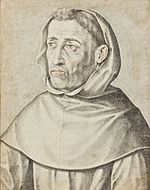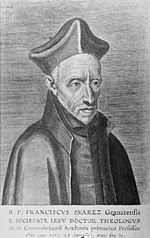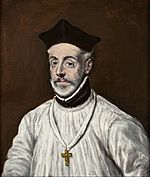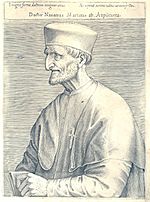School of Salamanca facts for kids
The School of Salamanca (Spanish: Escuela de Salamanca) was a group of smart thinkers, mostly from Spain, who lived during the Renaissance. They were mainly theologians (people who study religion) and jurists (people who study law). Their ideas came from the work of Francisco de Vitoria, who taught at the University of Salamanca.
In the early 1500s, many new things were happening. People started thinking differently about humans and their relationship with God. There was the rise of humanism, the Protestant Reformation, and new lands were being discovered during the Age of Exploration. These new challenges made the School of Salamanca think deeply about old ideas.
They believed in liberty (freedom) in a way that was new for Europe at the time. They focused on the natural rights of every person. This included rights like the right to live, the right to own property, and the right to freedom of thought.
The School of Salamanca also updated the idea of natural law. This is the idea that certain laws come from nature itself, and everyone shares them. They said that since all humans are naturally the same, they should all have the same rights to life and freedom. This was a big new idea, especially because many people at the time thought that people in the Americas did not have these rights.
Contents
History and Key Thinkers
The School of Salamanca had two main groups of thinkers. The first group was mostly Dominican friars, called the Salmanticenses. Later, from the late 1500s, came the Jesuit thinkers from the University of Coimbra, called the Conimbricenses. This showed how leadership in Catholic thought shifted from Dominicans to Jesuits.
The first group started with Francisco de Vitoria (1483–1546). Its peak was with Domingo de Soto (1494–1560). Important Jesuits included Luis de Molina (1535–1600), Francisco Suárez (1548–1617), and Giovanni Botero (1544–1617). Botero helped spread their ideas to Italy.
Key figures like Francisco de Vitoria, Domingo de Soto, Francisco Suárez, Martín de Azpilcueta, and Tomás de Mercado were all experts in natural law and morality. They worked to connect the teachings of Thomas Aquinas with the new political and economic world. They focused on human problems like ethics, money, and law.
Who Should Rule?
The School of Salamanca made a clear difference between two types of power. One was the natural or civil power (like a king's power). The other was supernatural power (like the Pope's power). In the Middle Ages, these powers were often mixed up. For example, kings sometimes chose bishops, or the Pope had power over earthly matters.
The School said that kings should not have power over people's souls. Also, the Pope should not have power over earthly governments. This meant there were limits to what a government could do.
For example, Luis de Molina thought a nation was like a business company. Those who govern have power, but this power comes from the people together. However, he also believed that a nation's government had more power over individuals than a company did over its members. This is because a nation's power came from God.
At this time, the king of England believed in the divine right of kings. This meant the king got his power directly from God, and people had to obey him. But the School of Salamanca disagreed. Many of them said that the people were the ones who received divine power. Then, the people could give this power to a ruler under certain conditions.
Francisco Suárez went even further. He wrote a book in 1613 called The Defense of the Catholic Faith. In it, he strongly supported the idea of popular sovereignty, meaning the people have the power. He said that people are born free, not as slaves. They can even disobey or remove an unfair government. Suárez believed that political power belonged to the people as a whole group, not just to separate individuals.
Gabriel Vásquez (1549–1604) added that natural law applies not just to individuals but also to societies. Societies must respect natural rights and justice.
Suárez also thought that a society's political power comes from an agreement, or social contract. This is because the community forms when free people agree to join together. This idea meant that the natural way to govern was either a democracy or a republic. Other forms, like oligarchy (rule by a few) or monarchy (rule by a king), were only fair if the people agreed to them.
Laws Between Nations
Francisco de Vitoria was very important in understanding ius gentium (the rights of nations) in early modern times. He thought that if rulers had fair power, then relations between nations should also be fair. He believed that the good of the whole world was more important than the good of any single country. This meant that countries should deal with each other based on law and right, not just by force. Some people call Vitoria, along with Grotius, the "father of international law."
Francisco Suárez further explained ius gentium. He separated ius inter gentes from ius intra gentes.
- Ius inter gentes is like modern international law. It was an agreement among most countries. Since it was a man-made law, it wasn't always universal.
- Ius intra gentes, or civil law, was the specific law for each nation.
Many scholars believe Vitoria and Suárez were key figures in starting the field of International law. They came before Grotius's famous book De iure belli ac pacis.
When is War Fair?
The thinkers of the School of Salamanca believed that war is one of the worst things that can happen. So, they said it should only be used when absolutely necessary to stop an even greater bad thing. They thought it was always better to try to make a deal through talking, even for the stronger side.
Here are examples of what they called "just war":
- Self-defense: If a country is attacked, it can fight back. But only if it has a good chance of winning. If it's sure to lose, fighting would just waste lives.
- Preventive war: Fighting against a tyrant who is about to attack another country.
- Punishment: War to punish an enemy who has done something very wrong.
But a war wasn't fair just because of its first reason. It also had to follow other rules:
- Fair response: The fighting must match the problem. Using too much violence would make the war unfair.
- People's consent: The government declares war, but that's not enough. If the people don't want the war, it's not fair. People have the right to remove a government that is fighting an unfair war.
- Moral limits: Even during a war, there are rules. For example, you can't attack innocent people or kill hostages.
- Last resort: War should only happen after all other peaceful ways, like talking and diplomacy, have failed.
Under these rules, wars fought to expand territory, to steal things, to force people to change their religion, or just for glory were always unfair.
The Conquest of America
In the 1500s, the School of Salamanca was the first to use the idea of natural law to question Spain's takeover of lands in the Americas. They said that rights belong to each person, including the native people there.
Francisco de Vitoria started by saying that some of Spain's reasons for taking land were "illegitimate." He was the first to question if the Pope's orders (called Bulls of Donation) gave Spain a real right to rule the new lands. Vitoria did not accept the emperor's power, the Pope's power (because he thought the Pope had no power over earthly things), or the idea that native people willingly gave up their lands or converted to Christianity.
He said that native people were not sinners or ignorant savages. They were free people by nature, and they had a right to their own property. When the Spanish arrived in America, they had no fair reason to take and rule those lands.
Vitoria also looked at what might be fair reasons to claim new lands. He listed up to eight "legitimate titles" (fair reasons).
- The first and most important was about people communicating. He said everyone has a universal right to travel and trade anywhere on Earth, no matter who rules or what religion they follow. If the native people in the Americas stopped this free travel, then the Spanish had the right to defend themselves. This defense could lead to taking land in a war of self-defense.
- The second fair reason was the Spanish right to preach and spread Christianity. Native people could choose not to convert. But if they stopped missionaries, it would be like the first case. However, Vitoria noted that even if this could be a reason for a fair war, it might not be wise because it would cause death and destruction.
Other possible fair reasons included:
- If pagan rulers forced Christians to go back to their old religions.
- If enough Christians lived in the new land and wanted a Christian government from the Pope.
- If a tyranny was hurting innocent people (like human sacrifice).
- If Spanish allies were attacked (like the Tlaxcaltecas, who were allied with the Spanish but ruled by the Aztecs). This could also justify a war and lead to fair conquest.
- The last "legitimate title" was one Vitoria himself doubted. It was the idea that native people might not be able to govern themselves well. This could be due to a lack of fair laws, leaders, or farming methods. But if land was taken this way, it had to be done with Christian kindness and only for the good of the native people.
Emperor Charles V of Spain did not like these ideas that limited his power. He tried to stop them from being taught, but he was not successful.
Money and Business
The School of Salamanca is sometimes called the "first economic tradition." This means they were among the first to think deeply about how economies work. Joseph Schumpeter praised their economic ideas in his book History of Economic Analysis. He said they deserved to be seen as the founders of economics as a science.
The School didn't create a full economic system. But they did come up with the first modern economic ideas to deal with new money problems that appeared after the Middle Ages. Sadly, their work wasn't continued for a long time, and many of their ideas were forgotten. Others later rediscovered them.
Their economic thinking was described as being "pro-market, pro-hard money, anti-state in many ways, pro-property, and pro-merchant." This means they liked free markets, stable money, less government control, private ownership, and supported merchants.
Some scholars, like Marjorie Grice-Hutchinson and Wim Decock, have written a lot about the School of Salamanca's economic ideas. Their ideas are similar to those of the Austrian School of economics. Murray Rothbard even called them "proto-Austrians."
Early Economic Ideas
In 1517, Francisco de Vitoria, who was studying in Paris, was asked by Spanish merchants if it was morally right to do business to get richer. They were basically asking about the ethics of being an entrepreneur. From then on, Vitoria and other thinkers started looking at economic issues. They moved away from old ideas and used new ones based on natural law.
They believed that the natural world should allow people, goods, and ideas to move freely. This helps people get to know each other and feel more connected. This meant that being a merchant was not bad. In fact, it helped everyone.
Owning Things Privately
Everyone in the School of Salamanca agreed that owning private property was good. It encouraged people to work harder, which helped the whole community. Diego de Covarubias y Leyva (1512–1577) thought that people had the right to own property. He also believed they had the exclusive right to benefit from it, even though the community might also gain. However, in times of great need, all goods could become shared.
Luis de Molina argued that people take better care of their own things than things that are owned by everyone. This is a bit like the idea of the tragedy of the commons.
Money, Value, and Price
The most detailed ideas about value from the School of Salamanca came from Martín de Azpilcueta (1493–1586) and Luis de Molina. Azpilcueta was interested in how the arrival of precious metals from the Americas affected prices. He showed that in countries where these metals were rare, their prices were higher than in places where they were common. He realized that precious metals got some of their value from being scarce. This idea of value based on scarcity was an early version of the quantitative theory of money, which Jean Bodin later developed.
Before this, the main idea was that the value of something was based on how much it cost to make it. But Diego de Covarrubias and Luis de Molina developed a new idea: the subjective theory of value. They said that how useful something is can be different for each person. So, fair prices would come from people freely buying and selling things. This would happen as long as there were no monopolies, fraud, or government interference. In today's words, they supported the free market, where the fair price of a good is set by supply and demand.
Luis Saravia de la Calle wrote in 1544: "Those who measure the just price by the labour, costs, and risk incurred by the person who deals in the merchandise or produces it, or by the cost of transport or the expense of traveling...are greatly in error.... For the just price arises from the abundance or scarcity of goods, merchants, and money...and not from costs, labour, and risk...."
Interest on Money
In the past, the Catholic Church saw usury (charging any interest on a loan) as wrong. In the Middle Ages, loans were usually given out of necessity, like for bad harvests. So, charging interest was seen as immoral.
But during the Renaissance, it became easier for people to move around and for entrepreneurs to start new businesses. Money was now borrowed not just for basic needs but also for making more money. So, the School of Salamanca found reasons to justify charging interest.
- The person receiving the loan benefited from it.
- Interest could be seen as a payment for the risk the lender took.
- There was also the idea of opportunity cost. The lender lost other chances to use their money while it was loaned out.
- Most originally, they saw money itself as a product. So, using one's money should earn a benefit in the form of interest.
Martín de Azpilcueta also thought about the effect of time. He came up with the idea of the time value of money. He said that, all else being equal, people prefer to get something now rather than later. This time preference means that getting something now has more value. So, interest is the payment for the time the lender is without their money.
Thinking About God

During the Renaissance, the study of theology (religion) was generally becoming less popular as humanism grew. But at the University of Salamanca, under Francisco de Vitoria, theology became very active again. They especially brought back the ideas of Thomas Aquinas (this was called a renaissance of Thomism). Their influence spread across Europe.
A key contribution of the School of Salamanca was studying problems that were closer to everyday human life. They asked new questions that hadn't been explored before. This new, more practical way of studying theology is sometimes called positive theology.
Morality
In a time when religion was a part of everything, studying the morality of actions was seen as the most useful way to help society. The School's new ideas in law and economics came from real-life challenges and moral problems that society faced.
Over time, a system called casuistry had developed. This was a set of fixed answers to moral problems. But this system could never cover every situation. So, people started looking for more general rules. This led to probabilism. This idea said that the most important thing was not necessarily finding the absolute truth, but being sure you weren't choosing something evil. Bartolomé de Medina, Gabriel Vásquez, and Francisco Suárez were key in developing probabilism. It became a very important way of thinking about morals for centuries.
Why is There Evil?
It has long been a puzzle why evil exists in a world created by a good and powerful God (this is called the Problem of evil). Vitoria explained this by saying that free will is a gift from God to each person. It's impossible for every person to always choose only good things. So, evil happens because people have the freedom to choose not to do good.
Members
There is some discussion about exactly who belongs to the School of Salamanca. But most agree that Francisco de Vitoria is the central figure. Scholars often divide the members into three groups: Vitoria's students and their students, other thinkers in Salamanca at the same time who weren't directly linked to him, and people outside Salamanca who were influenced by his ideas.
First group
- Arias Piñel (1512-1563)
- Antonio de Padilla y Meneses (-1580)
- Bartolomé de Albornoz (1519-1573)
- Bartolomé de Medina (1527-1581)
- Diego de Chaves (1507-1592)
- Diego de Covarrubias (1512-1577)
- Diego Pérez de Mesa (1563-1632)
- Domingo Báñez (1528-1604)
- Domingo de Soto (1494-1560)
- Fernán Pérez de Oliva (1494-1531)
- Francisco de Vitoria (1492-1546)
- Francisco Sarmiento de Mendoza (1525-1595)
- Francisco Suárez (1548-1617)
- Gregorio de Valencia (1549-1603)
- Jerónimo Muñoz (1520-1591)
- Juan de Horozco y Covarrubias (1540-1610)
- Juan de la Peña (1513-1565)
- Juan de Matienzo (1520-1579)
- Juan de Ribera (1532-1611)
- Juan Gil de la Nava (-1551)
- Leonardus Lessius (1554-1623)
- Luis de León (1527-1591)
- Martín de Azpilcueta (1492-1586)
- Martín de Ledesma (1509-1574)
- Melchor Cano (1509-1560)
- Pedro de Sotomayor (1511-1564)
- Tomás de Mercado (1523-1575)
Second group
- Alonso de la Vera Cruz (1507-1584)
- Cristóbal de Villalón (-1588)
- Fernando Vázquez de Menchaca (1512-1569)
- Francisco Cervantes de Salazar (-1575)
- Juan de Lugo y Quiroga (1583-1660)
- Juan de Salas (1553-1612)
- Luis de Molina (1535-1600)
- Pedro de Aragón (1545-1546)
- Pedro de Valencia (1555-1620)
Third group
- Antonio de Hervías (-1590)
- Bartolomé de Carranza (1503-1576)
- Bartolomé de las Casas (1484-1566)
- Cristóbal de Fonseca (1550-1621)
- Domingo de Salazar (1512-1594)
- Domingo de Santo Tomás (1499-1570)
- Gabriel Vásquez (1549-1604)
- Gómez Pereira (1500–1567)
- Juan de Mariana (1536-1624)
- Juan de Medina (1489-1545)
- Juan Pérez de Menacho (1565-1626)
- Luis de Alcalá (1490-1549)
- Luis Saravia de la Calle (?)
- Miguel Bartolomé Salón (1539-1621)
- Pedro de Fonseca (1528-1599)
- Pedro de Oñate (1567-1646)
- Rodrigo de Arriaga (1592-1667)
Images for kids
See also
 In Spanish: Escuela de Salamanca para niños
In Spanish: Escuela de Salamanca para niños
- Conimbricenses
- Second scholasticism
- Casuistry
- Rule According to Higher Law
- Social contract
- Valladolid debate
- Spanish Universalist School of the 18th century







